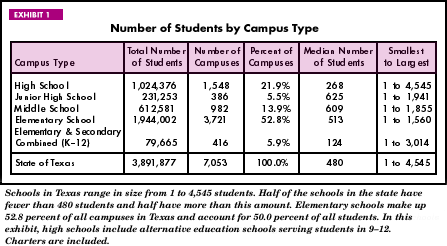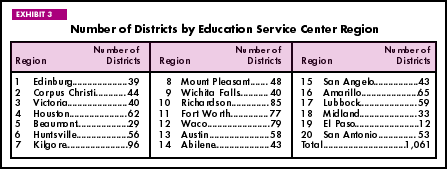
Texas Education AgencyThe Texas Education Agency
(TEA) is comprised of the commissioner of education and the agency staff.
The The SBOE consists of 15 elected members representing different regions of the state. One member is appointed chair by the governor. Dr. Jack Christie concluded his tenure as a member and chair of the board effective December 31, 1998. Mr. Chase Untermeyer, appointed by Governor George W. Bush in December 1998, replaces Dr. Christie as chair beginning January 1999, pending confirmation by the Texas Senate. Mr. Untermeyer's term as chair will expire January 1, 2001. A map showing 1997-98 SBOE district boundaries is included in the Endnotes. Located in Austin, Texas, the TEA is the administrative unit for primary and secondary public education. Under the management of the commissioner of education, the TEA accredits school districts; administers the statewide assessment system, curriculum development, and the textbook adoption process; operates research and information programs; monitors for compliance with federal and state guidelines; and serves as a fiscal agent for the distribution of state and federal funds. TEA operational costs are supported by both state and federal funds. In 1997-98, TEA employed 795 staff. A little more than half of all agency positions are funded with state dollars (51.8 percent). The remaining 48.2 percent are funded from federal contracts and dedicated fees (43.4 percent, and 4.8 percent, respectively). Local School Districts and ChartersSenate Bill 1, passed by the 74th Texas Legislature in 1995, established a new type of school, the open-enrollment charter school, which must be authorized by the SBOE to receive charter status and state funds. In 1995-96, the SBOE authorized 20 charters, one of which was subsequently revoked, leaving 19 in operation during 1997-98. Charters are subject to fewer state laws than other public schools and many are designed to serve students at risk of academic failure or dropping out of school. Like other public schools, they are monitored and accredited according to the standards of the statewide testing and accountability system. In 1997-98, the 19 charters served 3,856 students at 20 campuses (one charter operates two schools.) The charters join the 1,042 local school districts in providing services to public schoolchildren in Texas. While the SBOE and the commissioner of education provide leadership for education, much of the control of public schools resides with the local school districts and charters. Statute grants any responsibilities not specifically assigned to the SBOE or the TEA to the local school districts and charters. Districts and charters serve students in pre-kindergarten through grade twelve. There are over 7,000 public school campuses in Texas, the majority of which serve students in the elementary grades. The number of campuses in
a district varies greatly, depending primarily on the total number of
students enrolled
Districts and charters are classified according to governance structure and their ability to raise local revenue. The four types are defined as follows: 1) Regular Foundation School Program (FSP) Districts, or districts created under general statutory authority that are eligible for state funding assistance under the Foundation School Program. These districts may also tax property within their geographic boundaries. Most districts fall into this category--1,036 or 98 percent in 1997-98; 2) Special Statutory Districts, or districts created by a special legislative act but not administered by a state government agency. These districts have no taxable property and are almost wholly supported with state and federal money. They include the public schools associated with military bases in the San Antonio area, and the Masonic Home in Fort Worth. There are six of these districts; 3) State-Administered Districts, or districts created by a legislative act which are both funded and administered by a state government agency. Most of these 11 districts are administered by the Texas Department of Mental Health and Mental Retardation, and; 4) Open-Enrollment Charter Schools, or charters granted by the SBOE to operate in a facility of a commercial or nonprofit entity or a school district. Like the special statutory districts, the 19 charters have no taxable property and are almost wholly supported with state and federal money. Snapshot '98 includes data for the 1,036 regular FSP districts, the six special statutory districts, and the 19 charters. State-administered districts do not have the same reporting requirements and therefore, are not included. Regional Education Service CentersThe 20 regional education
service centers (ESCs) provide a variety of services to school districts
both within and outside their defined geographic boundaries. Differences
exist among the ESCs in terms of the number and characteristics of their
member districts. All ESCs furnish services that support improved student
achievement in
The ESCs collaborate with districts to provide technical assistance in the areas of accreditation and curriculum, professional staff development and administrator training, and PEIMS reporting. Service centers also provide schools with instructional technology; information services; and assistance in program improvement in areas such as bilingual education, special education, gifted and talented education, and programs for at-risk students. A regional certification officer provides technical assistance on teacher certification issues to schools within the region. Some functions of TEA were decentralized to the education service centers beginning in 1995. Many technical assistance functions and the mentor networks, along with several statewide projects, are now assigned to the ESCs. Assistance is targeted to those campuses in the greatest need of improvement and support. To this end, funding is provided to staff field service agents in each region. The field service agents work closely with school districts to help solve problems related to low student achievement and to facilitate communication between districts and the agency. Statistics for all 87 data items are summarized to the regional level in the Detailed Statistics. Additional information about the service centers is available from the agency's Education Service Center Support Unit. The various agencies of public education work together to provide a successful system of instruction in an extremely diverse state. The Texas Education Agency, the local school districts, the ESCs, and a number of other associations and organizations committed to educational excellence strive to meet the challenges of providing appropriate educational services to all the schoolchildren of Texas. |


